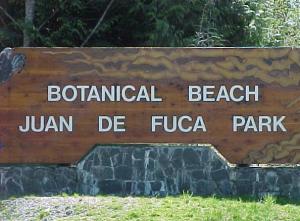 |
|
|
Sooke: Parks: Botanical Beach & Tidal Pools
Trail Head Juan de Fuca Marine Park CLICK HERE to view video of botanical beach
Shoreline trails with unique geological features |
|
||||||||||||||
|
Rich tide pools, a shoreline full of life and fantastic geological features impress visitors to Botanical Beach Provincial Park. The abundance of wildlife was what drew Dr. Josephine Tildon to choose Botanical Beach as the location for the University of Minnesota's marine station in 1900. For 7 years researchers and students came from all over the world to study here. To get to the station, a steamship would come from Victoria to Port Renfrew. From there it was on foot on a very muddy and narrow trail to the station. A better road in to the station was promised, however, it did not materialize and the difficult access was considered a reason for the station's closure in 1907. There are few remains of the station left today. Universities still use Botanical Beach for field trips and research, under park use permits. The area became a Class "A" Provincial Park in 1989; the highest level of protection to a park area. Natural History Botanical Beach has 251 ha of upland habitat, but is best known for its abundance of intertidal life. A visitor can find hundreds of species of plants and animals. The organisms that live here must be able to handle a wide range of conditions. When the tide is out there are large changes in temperature, predators, food sources and salinity. Each creature has adapted to contend with these
variable There are some plants and animals that are specialists to
the high impact waves found at Botanical Beach. The Gooseneck Barnacle, an animal, and the
Sea Palm, a brown algae, are two of these. These organisms survive in the surf zone by
being attached to the rock with flexible stalks
Purple sea urchins have established a particular niche in the soft sandstone. Their sharp, hard spines help to wear away indentations in which they live.
Watch the Ocean Killer Whales and Grey Whales have often been observed swimming past the beach or feeding just off the points. The best time to see Grey Whales is during their migration from the Mexican coast to Alaska during March and April. Both California and Northern Sea lions can be found here from late August through May. Harbour Seals are often seen offshore, they can be recognized by their basketball-shaped heads bobbing at the surface.
Geology The main tide pools and sculptured formations are formed out of soft sandstone. Some of the park's tide pools are formed by wave-tossed boulders grinding out pockets in the sandstone. Purple sea urchins further modify these tide pools by grinding out small pockets. Ridges of shale and quartz jut up through black basalt, and the southern cliffs form some of the most photogenic landscapes found on southern Vancouver Island.
Photo Gallery
Where exactly is it?
Visitor Safety
All information courtesy of BC Parks, for further information please
contact:
|
|||||||||||||||
|
|
|||||||||||||||


 conditions. Organisms that can not cope with drying will survive in the
tide pools or in shaded crevices. There you will find congregations of sea stars, chitons and
anemones, the sea stars often piled together to conserve moisture loss. Barnacles, snails
and mussels are able to survive by closing up tightly with a small amount of water inside
their shells.
conditions. Organisms that can not cope with drying will survive in the
tide pools or in shaded crevices. There you will find congregations of sea stars, chitons and
anemones, the sea stars often piled together to conserve moisture loss. Barnacles, snails
and mussels are able to survive by closing up tightly with a small amount of water inside
their shells. that bend with the force of the waves.
They are just two of the thousands of species of marine invertebrates and algae that can
be found here at low tide.
that bend with the force of the waves.
They are just two of the thousands of species of marine invertebrates and algae that can
be found here at low tide. 

















